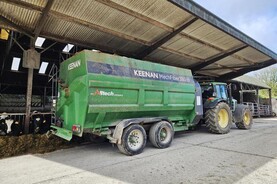An assessment of the physical fibre content of the total mixed ration (TMR) being fed to the lactating groups was carried out on James Martin’s farm in Co Armagh.
Diets with reduced particle size have been shown to lead to a reduced amount of time spent chewing by dairy cows and an increased risk of acidosis.
But when particle size is too long, there is an increased risk of dietary sorting by cows and, ultimately, the diet consumed is very different to the one originally formulated.
A Penn State particle separator kit is composed of four trays with differing sieve sizes (0mm to 19mm).
Sieve
These are placed on top of each other in order of increasing sieve size.
A TMR sample is placed in the top tray and the sample is shaken.
The resultant material which is caught in each tray is weighed to determine the proportion of different sized particles within the ration.
The findings for the Martin farm are outlined in Table 1.
While the figures shown for the diet in the upper trays (larger sieve sizes) may not appear to match the original targets set, this is probably due to differences in chop length and dry matter content between local dairy cow diets and North American rations.
The results from the lower trays (smaller sieve sizes) more closely matched targets and the butterfat of milk produced recently has been strong for the herd at 4.25%, suggesting the physical structure of the diet is adequate.






 This is a subscriber-only article
This is a subscriber-only article











SHARING OPTIONS: